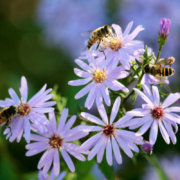Low-Allergen Flowers That Don’t Attract Bees
Gardening offers peace and beauty, but for allergy sufferers and those wary of bees, flower selection becomes crucial. While bees are essential pollinators, not everyone wants to invite them into their garden—especially if allergies or insect phobias are a concern. Choosing low-allergen flowers that don’t attract bees allows you to enjoy a colorful, lush landscape without the buzzing guests. Whether you’re designing a home garden or maintaining a public green space, selecting the right plants can help minimize allergic reactions and reduce bee activity naturally, while still keeping your garden vibrant and inviting.
Why Some Flowers Attract Bees More Than Others
Not all flowers are created equal when it comes to attracting bees. Bright colors, strong fragrances, and open petals typically signal a flower that’s rich in nectar or pollen—an irresistible invitation for bees. Flowers in the blue, purple, and yellow spectrum are particularly appealing to them. Additionally, composite flowers like daisies and sunflowers tend to attract bees due to their accessible pollen structure. On the other hand, flowers with double petals, minimal fragrance, or low pollen content are far less likely to attract bees. Understanding these traits helps you plan a more allergy-friendly and bee-averse garden.
Best Low-Allergen Flowers That Won’t Attract Bees
If you’re aiming to enjoy your garden without constant bee traffic, several beautiful flowers won’t attract bees and are also low in allergens. Petunias, for instance, offer vibrant colors but little nectar, making them unattractive to pollinators. Similarly, begonias and impatiens add lush greenery and blooms without drawing in bees. Hydrangeas, though large and showy, are typically not a bee favorite. Marigolds, especially the French variety, emit a scent that tends to repel bees. If bee activity around your home is unusually high despite your efforts, you may want to consider contacting a reliable bee removal service in Nashville, TN for professional assessment and humane removal options.
The Role of Fragrance and Color in Bee Behavior
Bees use their sense of smell and color vision to identify suitable flowers for pollination. Flowers that emit strong, sweet scents tend to attract bees the most, while those with little to no fragrance are often overlooked. Bright yellow and purple flowers send visual cues that a food source is nearby. On the contrary, red flowers are less visible to bees due to their color spectrum limitations. Opting for red, white, or pastel-colored flowers can help minimize bee interest. By choosing low-fragrance, visually muted plants, you reduce the likelihood that your garden will attract bees unnecessarily.
Avoiding High-Pollen Plants and Wind-Pollinated Species
While bees are often associated with high-pollen flowers, it’s also important to avoid wind-pollinated species if allergies are a concern. Trees like birch, oak, and elm, as well as grasses like Bermuda and Timothy, release large quantities of pollen that can trigger allergic reactions. Even though these plants don’t necessarily attract bees, they can worsen seasonal allergies. Instead, focus on sterile hybrids or cultivars labeled as “low pollen” or “pollen-free.” These are ideal for allergy-prone individuals who also wish to limit bee visits. When selected carefully, your garden can be both beautiful and breathable.
Creating a Bee-Resistant Landscape
Designing a landscape that doesn’t attract bees involves more than just plant selection. Placement and plant diversity also play significant roles. Avoid clustering similar flowers together, as mass plantings can become a beacon for pollinators. Instead, break up flowering sections with ornamental grasses, evergreens, or hardscape elements like stone paths and water features. Incorporate non-flowering ground covers and shrubs to create variety without increasing pollen levels. By intentionally structuring your space, you not only reduce allergy triggers but also limit the appeal of your garden to bees looking for their next nectar fix.
Alternatives to Traditional Flowering Plants
If you want the aesthetics of flowers without actually using blooms that attract bees, consider foliage-forward plants. Hostas, coleus, caladiums, and dusty miller provide color and texture without enticing pollinators. Some ornamental grasses like blue fescue and mondo grass offer visual interest with zero bee attraction. You can also add decorative containers, sculptures, or colorful furniture to introduce vibrancy without relying on floral displays. These creative alternatives ensure your outdoor space remains lively, allergy-friendly, and peaceful. This approach is especially useful in communal spaces like schools, hospitals, and office complexes where bee presence can be problematic.
Consider Seasonal Blooming Patterns
Managing when your plants bloom is another strategic way to reduce the chances they’ll attract bees. Most bees are active in late spring and summer. By focusing on early spring or late fall bloomers, you can reduce bee encounters while still enjoying seasonal beauty. Some late bloomers like chrysanthemums and some varieties of camellias tend to produce less pollen and are less likely to draw in bees. Consult local gardening guides to find region-specific, low-allergen species that avoid peak pollinator season. This technique keeps your garden attractive year-round without constant buzzing interference.
Conclusion
A bee-free and low-allergen garden is entirely achievable with mindful planning and plant selection. By focusing on low-pollen flowers that don’t attract bees, minimizing bright and fragrant blooms, and incorporating texture-rich foliage, you can create a peaceful retreat that’s safe for allergy sufferers and free from uninvited buzzing guests. While bees have their place in nature, they don’t need to be part of your daily outdoor experience. With the right choices, you’ll enjoy the beauty of gardening without the stings, sneezes, or stress.

